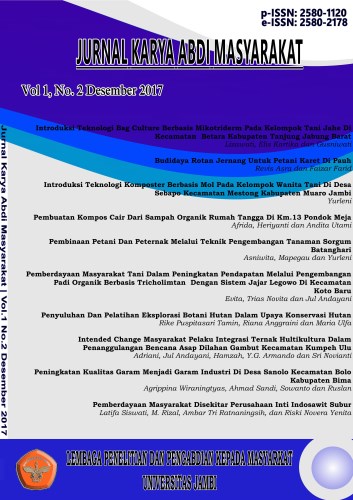BUDIDAYA ROTAN JERNANG UNTUK PETANI KARET DI PAUH
DOI:
https://doi.org/10.22437/jkam.v1i2.4284Abstract
Rotan jernang (Daemonorops spp.) merupakan salah satu jenis rotan yang menghasilkan resin merah pada permukaan kulit buahnya. Resin merah jernang ini bernilai ekonomi tinggi dan dimanfaatkan untuk obat-obatan dan perwarna. Rotan jernang di hutan Kecamatan Pauh memiliki keanekragaman genetik yang tinggi, sehingga jernang di lokasi ini merupakan sumber plasma nutfah Jambi yang berpotensi tinggi untuk dikembangkan. Menurut Balai Informasi Kehutanan Provinsi Jambi tahun 2009, keberadaan rotan jernang saat ini sudah langka. Oleh karena itu upaya budidaya harus dilakukan. Kendala yang dihadapi oleh masyarakat petani karet dalam budidaya rotan jernang adalah sulitnya memperoleh biji tua jernang sebagai sumber bibit. Dalam pelaksanaan kegiatan Pengabdian Pada Masyarakat, metode pengabdian yang digunakan yaitu Participatory Rural Apraisal (PRA), yaitu metode pendidikan pada masyarakat. Metode PRA ini memiliki kelebihan, dimana keterlibatan masyarakat secara aktif (sebagai subyek) dan Perguruan Tinggi sebagai fasilitator. Kegiatan sosialisasi dan pelatihan budidaya rotan jernang telah dilaksanakan di desa Karang Mendapo dan Batu Ampar Kecamatan Pauh, Kabupaten Sarolangun bersama kelompok tani Belato Makmur dan Makmur Utama. Sosialisasi dengan anggota kelompok tani berlangsung lancar, karena ketua IbM telah mengenal ketua kelompok tani, pada saat melakukan penelitian tentang jernang di daerah Kecamatan Pauh. Anggota kelompok tani sangat antusias dalam mengikuti kegiatan sosialisasi, karena mereka berharap dengan integrasi tanaman jernang di kebun karet mereka dapat meningkatkan perekonomian mereka. Berhubung sulitnya memperoleh biji tua untuk jenis jernang unggul (Daemonorps draco) yang memiliki nilai jual getah jernang paling tinggi, maka ketua peneliti berinisiatif untuk membeli anakan jernang dari pemilik kebun jernang dan para pencari jernang. Anakan jernang ini ada yang diperoleh dari jernang yang telah dikebunkan dan ada juga yang dari hutan alam. Anakan yang diperoleh selanjutnya ditanam di dalam polybag dengan media tanam tanah, pasir dan pupuk kandang. Hasil monitoring pertumbuhan menunjukkan bahwa persentase pertumbuhan anakan mencapai 60 %.
Downloads
Downloads
Published
Versions
- 2017-12-15 (1)
- 2017-12-15 (1)
How to Cite
Issue
Section
License
Please find the rights and licenses in Jurnal Jurnal Karya Abdi Masyarakat (JKAM).
- License
The non-commercial use of the article will be governed by the Creative Commons Attribution license as currently displayed on Creative Commons Attribution 4.0 International License.
- Authors Warranties
The author warrants that the article is original, written by stated author(s), has not been published before, contains no unlawful statements, does not infringe the rights of others, is subject to copyright that is vested exclusively in the author and free of any third party rights, and that any necessary written permissions to quote from other sources have been obtained by the author(s).
- User Rights
JKAM's spirit is to disseminate articles published are as free as possible. Under the Creative Commons license, JKAM permits users to copy, distribute, display, and perform the work for non-commercial purposes only. Users will also need to attribute authors and JKAM on distributing works in the journal.
- Rights of Authors
Authors retain the following rights:
- Copyright, and other proprietary rights relating to the article, such as patent rights,
- The right to use the substance of the article in future own works, including lectures and books,
- The right to reproduce the article for own purposes, provided the copies are not offered for sale,
- The right to self-archive the article.
- Co-Authorship
If the article was jointly prepared by other authors, the signatory of this form warrants that he/she has been authorized by all co-authors to sign this agreement on their behalf, and agrees to inform his/her co-authors of the terms of this agreement.
- Termination
This agreement can be terminated by the author or JKAM upon two months notice where the other party has materially breached this agreement and failed to remedy such breach within a month of being given the terminating party notice requesting such breach to be remedied. No breach or violation of this agreement will cause this agreement or any license granted in it to terminate automatically or affect the definition of JKAM.
- Royalties
This agreement entitles the author to no royalties or other fees. To such extent as legally permissible, the author waives his or her right to collect royalties relative to the article in respect of any use of the article by JKAM or its sublicensee.
- Miscellaneous
JKAM will publish the article (or have it published) in the journal if the articles editorial process is successfully completed and JKAM or its sublicensee has become obligated to have the article published. JKAM may conform the article to a style of punctuation, spelling, capitalization, referencing and usage that it deems appropriate. The author acknowledges that the article may be published so that it will be publicly accessible and such access will be free of charge for the readers.








